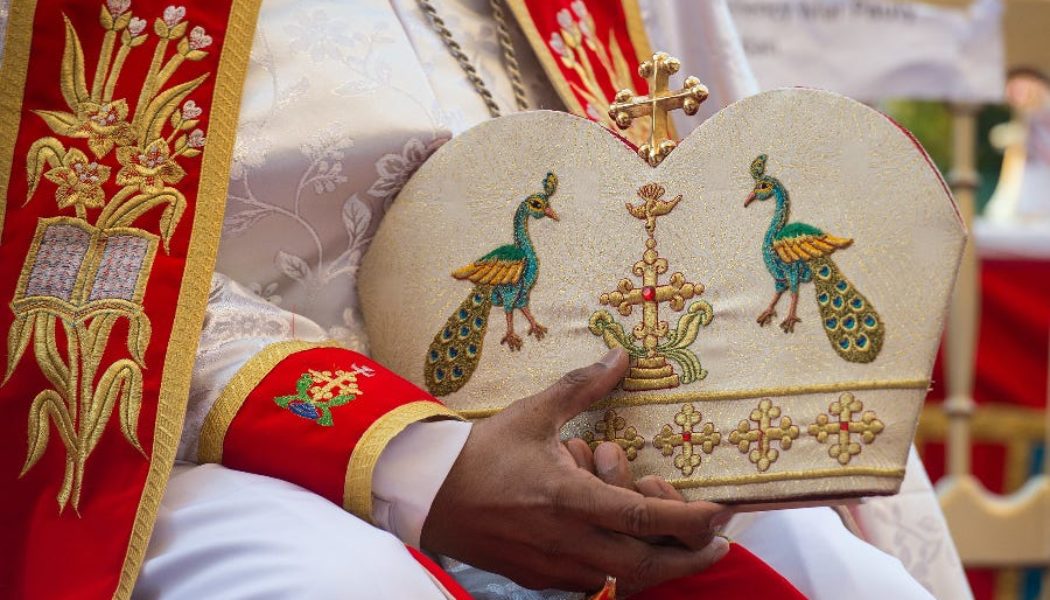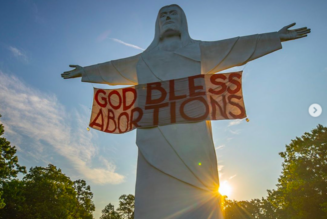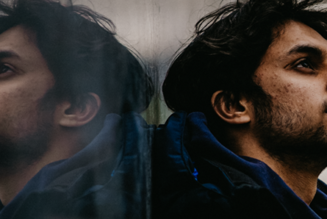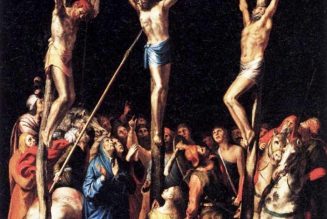
It is sometimes said that Pope Francis’ 2021 apostolic letter Traditionis custodes reignited the “liturgy wars” in the Catholic Church.
But for decades a liturgical dispute has raged within one of the most dynamic parts of the Catholic world. Its partisans have come literally to blows in a struggle that makes the dispute over the Traditional Latin Mass seem mild.
The conflict has drawn the attention of the pope. But outside the Vatican, it remains little known – much less understood – among Western Catholics.
Naturally, Latin Rite Catholics will seek to make comparisons between their own battles and this dispute. But first, it’s worth trying to grasp the specifics of the liturgical conflict within the Syro-Malabar Catholic Church.
The Church’s Syro-Malabar liturgy war has reached a boiling point, and no one is sure if the end is in sight.
What is the Syro-Malabar Church?
The Syro-Malabar Church is one of the 23 self-governing Eastern Catholic Churches in full communion with Rome. It is the second-largest after the Ukrainian Greek Catholic Church, with around 4 million members located mainly in India but also in diaspora communities in the United States, Britain, Australia, and elsewhere.
The Church traces its origins to St. Thomas the Apostle, who according to tradition traveled to southern India after the Resurrection and founded a community that became known as the Saint Thomas Christians.
The community, shaped by Syriac Christianity, split over the centuries into a multiplicity of groups including Catholics, Protestants, and Oriental Orthodox Christians.
The Syro-Malabar Church is one of two Eastern Catholic Churches based in Kerala, a small state on India’s southwest coast. The other is the Syro-Malankara Catholic Church. Syro-Malabar Catholics follow the East Syriac Rite, while Syro-Malankara Catholics employ the West Syriac Rite.
The name “Syro-Malabar” is a combination of the word “Syriac,” referring to its liturgy, and “Malabar,” an older name for the region. The Church’s members speak Malayalam.
To simplify a complex history, the Syro-Malabar Church grew out of the ancient Syriac Christian world, but came into the orbit of the Latin Church in the 1500s and underwent Latinization – its own practices and traditions were influenced and shaped by the theology and practices of Rome.
But from the late 1800s onward, the Vatican began to grant Syro-Malabar Catholics ever greater powers of self-governance, in recognition of the community’s distinctive ancient Eastern Christian roots.
The shift was part of a broader recognition of distinct Eastern Catholic identity and authority – and cautions against swallowing up Eastern traditions into the Latin Church.
In the 1894 encyclical Orientalium dignitas, Leo XIII declared that the diversity of liturgical forms in the Eastern Church had “redounded tremendously to the glory and usefulness of the Church.” He underlined that it was “in the best interest of all that their discipline not haphazardly borrow anything that would be ill-suited from Western ministers of the Gospel.”
A century later, Pope John Paul II gave in 1992 the Syro-Malabar Church “major archiepiscopal” status- a milestone in its history.
The move meant that the Church would be led by a major archbishop, with most of the powers of an Eastern patriarch, assisted by a synod of bishops.
Many Syro-Malabar Catholics describe their Church as a vigorous spiritual body. The Syro-Malabar Vocation Commission, for example, says that “the Syro-Malabar Church, with its deep-rooted spirituality and high rate of vocations to priesthood and religious life, can be considered as the most vibrant Catholic community in the world.”
But not all members agree with that upbeat assessment. One Syro-Malabar Catholic, commenting on background, likened the Church’s hierarchy to the Irish bishops in the 1980s: influential in the public sphere but studiously ignoring underlying internal problems.
Whether the Syro-Malabar Church is an awe-inspiring community or a top-heavy one heading for a fall – or both – is a matter of debate among the Church’s own members.
But one thing is clear from its history: it has a dual identity. Both Eastern and Western Christianity have left their mark. Today, the Syro-Malabar Church faces both East and West.
So it’s fitting, perhaps, that the Church’s liturgical dispute is – at least superficially – about whether its priests should look east or west at the altar.

‘A unique mystical world’
The Eucharistic liturgy of the Syro-Malabar Church is known as the Holy Qurbana (“offering” or “gift”). It has three forms: a simplified form for daily use, a standard version for use on Sundays, and a form employed on very solemn days known as the Raza (thought to mean “mystery”).
The structure differs from that of the Mass celebrated in the Latin Church. In the Raza, for example, the Our Father is recited three times, rather than once, and there are four Scripture readings (from the Law, the Prophets, the Apostles, and the Gospel).
“The Syro-Malabar tradition summarizes the whole mystery of salvation in its celebration of the Eucharist,” writes Fr. Joseph Varghese Kureethara, a member of the Carmelites of Mary Immaculate, the first indigenous Indian Catholic religious congregation.
Fr. Kureethara describes the Holy Qurbana as “a liturgy that presents a unique mystical world.”
This YouTube video of the Holy Qurbana, celebrated at a church in the Kerala town of Kuravilangad, gives a sense of what he means:
The quest for uniformity
From the Church’s earliest days, Syro-Malabar priests celebrated the Eucharistic liturgy facing east (ad orientem), and with the congregation behind them. They continued to do so during the period of Latinization, an era in which Western clergy also celebrated Mass ad orientem.
But after Vatican II, the movement to celebrate the liturgy facing the people (versus populum) reached India, and in some places Syro-Malabar priests adopted the practice.
Still, within the Syro-Malabar Church, the Second Vatican Council unleashed another – perhaps contradictory – impulse, as well.
Orientalium ecclesiarum, the council’s decree on the Eastern Catholic Churches, declared that Eastern Catholics “should know and be convinced that they can and should always preserve their legitimate liturgical rite and their established way of life, and that these may not be altered except to obtain for themselves an organic improvement.”
The text was an encouragement to the group of Syro-Malabar Catholics who wanted to rediscover the Church’s ancient liturgical roots, and restore the Holy Qurbana to its original form, absent some of the Latin influences that had crept in over the centuries. They got to work on restoring liturgical texts, which eventually were approved by Church leaders.
Pope John Paul II formally inaugurated the restored liturgy – known as the “Order of the Solemn Raza of the Syro-Malabar Church” – when he visited the Indian city of Kottayam on Feb. 8, 1986.
But after the restored liturgy was launched, some clergy were unenthusiastic about the new text, and hung on to celebrating in the form they were used to. Some said the changes were to a liturgical text that was theologically complicated, its meaning beyond the grasp of ordinary Syro-Malabar Catholics. Others said the text was old-fashioned, and too stilted to be beautiful.
One Syro-Malabar prelate, Cardinal Joseph Parecattil of Ernakulam, said the new text “presented evidence of no serious concern for contemporary pastoral exigencies.”
In his 1987 work “The Restoration of the Syro-Malabar Qurbana,” theologian Fr. Thomas Mannooramparampil argued that the refusal to use the approved text “caused scandal and division in the Church.”
“The root cause of the liturgical crisis in the Church is the lack of the oriental formation and ecclesial sense among our clergy and the faithful. Our Church has her own liturgy, history, and spirituality,” he wrote.
“In order to activate the ongoing liturgical and ecclesial renewal of the Church the implementation of the restored Qurbana everywhere is important,” he argued. “Any change in it or delay in its implementation will be detrimental to the restoration, renewal, and growth of the Church.”
A Syro-Malabar priest, who asked not to be named because of the ferocity of the liturgical dispute, told The Pillar that the effects of Latinization were still felt today.
“Our mind is very much Latinized and we have difficulty to follow the Oriental teachings,” he said. “But I think the new generation, they are very much interested in the Oriental tradition.”

Compromise efforts
The Synod of Bishops – a body which can enact liturgical laws for all Syro-Malabar eparchies (dioceses) – discussed for years how to introduce a uniform mode of celebrating the Eucharistic liturgy.
In 1999, a compromise – known as the “50:50 formula” – was reached.
The priest would face the people during the Liturgy of the Word and then turn east for the Liturgy of the Eucharist.
But again, despite Vatican support, not all clergy got onboard. Liturgical practice remained divided.
Two decades later, the bishops decided to seek a decisive papal intervention. In July 2021, Pope Francis wrote a letter exhorting all Syro-Malabar Catholics “to proceed to a prompt implementation of the uniform mode of celebrating the Holy Qurbana, for the greater good and unity of your Church.”
The pope described the 1999 agreement on the uniform mode as “an important step towards increasing stability and ecclesial communion” and said that observing the approved norms had “borne considerable fruit including evangelization in those places, especially the missionary eparchies, where the whole community has joined in peaceful and prayerful observance.”
In August 2021, the Syro-Malabar Synod of Bishops approved the introduction of the uniform liturgy in all eparchies, announcing that the transition would begin on Nov. 28, the first Sunday of Advent. Dioceses where the change might be problematic were given until Easter Sunday 2022.
To say that it did not go according to plan would be an understatement.
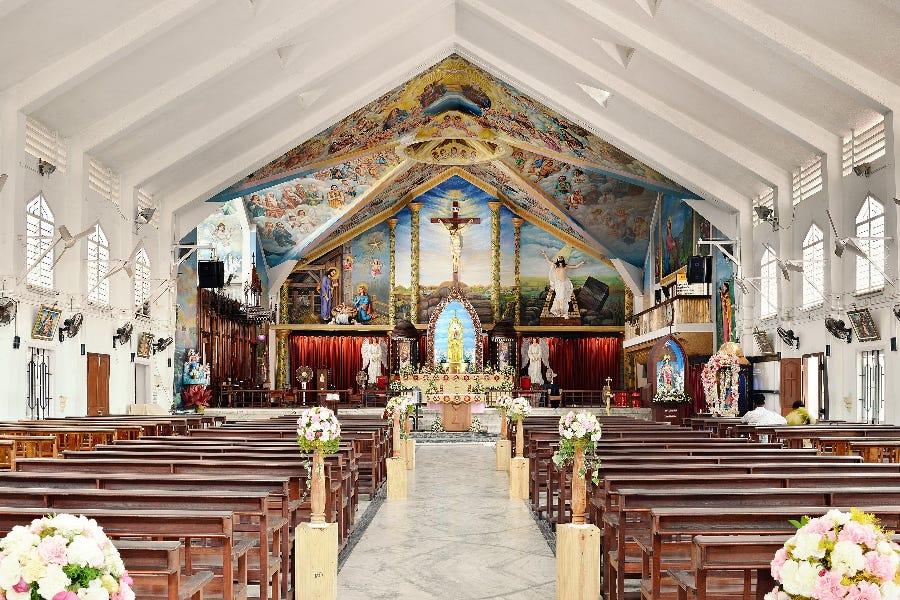
Trouble in Ernakulam-Angamaly archdiocese
The focal point of resistance to the uniform liturgy was the Archdiocese of Ernakulam-Angamaly, which occupies a unique position in the Syro-Malabar world.
When the Church was given major archiepiscopal status in 1992, the archdiocese was recognized as the see of the major archbishop.
But the archdiocese is at the center of a complex and long-running controversy known as the “land deal scam,” concerning real estate transactions that lost the archdiocese a reputed $10 million and led to legal proceedings. The scandal sparked what became known as the “Ernakulam priests’ revolt,” in which clergy demanded the removal of the major archbishop, Cardinal George Alencherry.
The cardinal has always maintained his innocence and the Kerala state government said this month it agreed with that assessment. But in June 2018 the Vatican appointed a temporary apostolic administrator who oversaw the archdiocese for a year. In August 2019, Pope Francis confirmed the Synod of Bishops’ decision to elect Archbishop Antony Kariyil as the archiepiscopal vicar of Ernakulam-Angamaly archdiocese, who would be responsible for day-to-day administration.
The influential archdiocese became a tinderbox, with a history of clergy activism — and a history of skepticism about the restored liturgy from its one-time leader, Cardinal Parecattil.
And then the drive for a uniform liturgy accelerated.

The ‘April showdown’
Shortly before the November 2021 deadline for change, Pope Francis granted Archbishop Kariyil a private audience at the Vatican.
Soon after the meeting, Cardinal Leonardo Sandri, prefect of the Congregation for the Eastern Churches, confirmed that Archbishop Kariyil could “apply the faculty of dispensation for those cases which, in your prudential judgment, would result in grave consequences.” The archbishop immediately issued a broad exemption.
When the Advent deadline passed, all eparchies except Ernakulam-Angamaly moved to the new format, though there was reportedly some demand for Mass versus populum to continue in the dioceses of Faridabad, Irinjalakuda, Thrissur, Thamarassery, Mananthavady, and Palghat.
At the end of 2021, a group of six retired bishops wrote a confidential 10-page letter to their brother Syro-Malabar bishops, copied to Vatican officials.
The letter said that the decision to implement the uniform mode “was not reached through proper, mandatory consultations, and transparent procedures” and was therefore “a cause of disunity in the Church.”
The six bishops complained that the Synod of Bishops’ decision “was not, in fact, unanimous,” though “some tried to create the impression” that it was.
Meanwhile, a growing group of priests in the Ernakulam-Angamaly archdiocese did not want to change their liturgy, and their position seemed to have support from the retired bishops.
So at the start of 2022, priests in Ernakulam-Angamaly began a hunger strike in protest at the change. They only agreed to eat when Archbishop Kariyil said that he would not support the Synod of Bishops’ decision — the priests could keep their liturgy.
But not for long.
At least, not if the Vatican had anything to say about it.
In February, Cardinal Sandri – who oversees Eastern Churches at the Vatican – pushed for the Ernakulam-Angamaly archdiocese to adopt the restored liturgy, in line with the other eparchies of the Syro-Malabar Church.
The cardinal wrote to Archbishop Kariyil, asking him to “revoke the dispensation incorrectly extended to the entire Archeparchy for an indefinite period.” He said that Kariyil’s decisions to approve dispensations “in some special cases” had to be approved by Cardinal Alencherry.
“The Apostolic See understands that some have difficulty in following the synodal decisions, but exhorts all to avoid activism and protests using non-ecclesial and non-Christian methods such as hunger strike usque ad mortem [until death],” Sandri wrote.
A few weeks later, activists burned effigies of Cardinal Sandri and Cardinal Alencherry in the city of Kochi, as clergy of Ernakulam-Angamaly archdiocese met to discuss their next steps. This YouTube video shows the scene, which was condemned by the archdiocesan authorities:
The priests of Ernakulam-Angamaly archdiocese urged Archbishop Kariyil not to withdraw the exemption and called for “official recognition” of Mass facing the people as a “liturgical variant.”
On March 25, Pope Francis sent another letter, this time directed to the clergy of the archdiocese, urging them to take the “difficult and painful step” of adopting the uniform liturgy by Easter Sunday.
The priests proposed a compromise: they would make the change at Christmas so that they had time to catechize their people. Archbishop Kariyil adjusted his dispensation so that the exemption would end on Dec. 25, 2022.
But the proposal was rejected by the Synod of Bishops.
A joint statement signed by Cardinal Alencherry and – controversially – by Archbishop Kariyil, insisted on the Easter Sunday deadline.
The dispute came to a head on April 8, when the clergy of Ernakulam-Angamaly archdiocese held an emergency meeting at the major archbishop’s residence. According to an official statement from the archdiocese, Archbishop Kariyil told priests that he was “forced to sign” the joint statement under “overwhelming pressure from the members of the synod.” The priests declared that the statement was invalid under Church law and Mass facing the people would continue in the archdiocese.
After the meeting, Fr. Kuriakose Mundadan, secretary of the clergy council of Ernakulam-Angamaly archdiocese, spoke to the media at the entrance of the archbishop’s house, surrounded by fellow priests.
There are competing versions of what happened next, but according to one eyewitness, the press conference was interrupted by activists who backed the restored liturgy, “murmuring expletives against the priests.”
Lay people supporting the clergy then “beat the activists and chased them out.”
The melee continued, drawing in members of a group which had protested at the site for more than a month under the slogan “With the Pope and the Synod.”
Video shot on the day gives a sense of the chaotic and angry nature of the disturbance, which saw men fighting with what appeared to be microphone stands before police intervened to restore order:
On April 10, Cardinal George Alencherry formally launched the uniform liturgy at St. Mary’s Syro-Malabar Cathedral Basilica in Ernakulam, under police protection.
One writer claimed that those present included “3 Deputy Superintendents of Police, 4 Inspectors, 12 Sub-Inspectors, 12 women police, 31 Special branch police and 12 Commando force,” as well as plainclothes police officers.
Archbishop Kariyil was not present.
Still, the Easter Sunday deadline passed a week later, but with the dispute unresolved.
Resisting uniformity
Fr. Joyce Kaithakottil, a priest of Ernakulam-Angamaly archdiocese, told The Pillar that, in his view, celebrating the Holy Qurbana facing the people was an expression of legitimate diversity within the Syro-Malabar Church.
“In our pastoral situation, we have been following a beautiful custom of celebrating Mass facing the people for more than 50 years. We do not find any solid reason to change this custom that is being loved and meaningfully practiced by the people and the celebrants,” he said.
The priest noted that advocates of ad orientem worship emphasized that the Syro-Malabar Church’s liturgical tradition was entwined with that of the Iraq-based Chaldean Catholic Church. But “the same Chaldean Church is opening up a possibility for both the ways of celebration,” the 59-year-old priest said.
“Most of the dioceses like Ernakulam had imbibed the spirit of the Second Vatican Council and started implementing this mode of celebration more than 50 years back,” he observed, “but Changanacherry diocese and a very few other dioceses continued the mode of celebration as it was before the Council.”
“Even in those dioceses, some priests were celebrating Mass versus populum. The people of God found it very participatory and meaningful and it continued without any interruption.”
Fr. Kaithakottil explained that the Ernakulam-Angamaly archdiocese had distinctive features that gave it a prominent role in the uniform liturgy debate. There is a strong Latin Catholic presence in the archdiocese. The two archbishop’s houses – Syro-Malabar and Latin – are located near each other.
He said that the archdiocese was known for its “creative and innovative programs.”
And Cardinal Parecattil, the archbishop of Ernakulam from 1956 to 1984, opposed the liturgical changes, because he believed they were not pastoral, too esoteric, and incomprehensible to most people. The influence of those reservations remains evident in the Ernakulam-Angamaly archdiocese.
Parecattil took part in the Second Vatican Council and later held study workshops across the archdiocese “trying to inculcate the spirit” of the ecumenical council, Kaithakottil noted.
“The whole concept of Mass versus populum is also evolved in line with the spirit of the Second Vatican Council,” Fr. Kaithakottil said, adding the archdiocese had also led the way in forming lay consultation bodies.
Fr. Kaithakottil disputed the legitimacy of the Synod of Bishops’ August decision. In his view, the mandate to introduce the uniform liturgy throughout the Church was not truly synodal because “there should have been dialogue with the priests and laity.”
He suggested that the best way to resolve the tensions around the uniform liturgy was to accept a degree of diversity.
“Think of India – a land of multicultural, multi-religious, multi-ethnic realities are found everywhere,” he said. “Some are intolerant to accept the diversity. The synod has to allow the Mass facing the people as a liturgical variant in the Syro-Malabar Church.”
The priest underlined that Ernakulam-Angamaly archdiocese had accepted the liturgical text of the restored liturgy, just not its uniform mode of celebration.
“Let there be a synodal process in the finalization of the mode of celebration. Then you would understand that not some Syro-Malabar Catholics but most of the laity and priests would opt for the Mass versus populum in the Syro-Malabar Church,” he said.
Supporters of the uniform Mass, however, insist that the majority of Syro-Malabar Catholics are on their side.
What’s next?
Indian media reported that a delegation from Ernakulam-Angamaly archdiocese visited the Vatican in June and met with Cardinal Sandri. The outcome is unknown, but the trip implies that communication channels are still open.
“The Vatican is firm and Pope Francis is also firm,” said a Syro-Malabar priest familiar with the latest developments. “Now we are living in an era of synodality and the Vatican congregation gave a chance [to the delegation] to talk.”
When the Synod of Bishops meets again in Kerala in August, the bishops will be able to assess together the turbulent events of recent months.
Opponents of the uniform liturgy hope the Vatican will ultimately give the Ernakulam-Angamaly archdiocese a waiver. But officials could be reluctant to do so, because Pope Francis has put his authority firmly behind the changes and any exceptions would trigger similar requests from clergy in other eparchies.
Some critics of the uniform mode would like to see Rome go a step further, and create a new Eastern Catholic Church to accommodate them. They cite the example of the Eritrean Catholic Church, which the Vatican recognized in 2015 as distinct from the Ethiopian Catholic Church. They also note that some Eastern Catholic Churches are tiny. The Albanian Greek Catholic Church, for example, is thought to have fewer than 4,000 members.
But the parallels are not exact: the Eritrean Catholic Church was formed after Eritrea split from Ethiopia following a brutal 30-year war of independence. The Vatican was recognizing a new political reality. The Albanian Greek Catholic Church dates back to the 17th century and is based in a small country that endured decades of state-sponsored atheism, so its small size is due to geographical and historical factors.
It’s hard to imagine that Pope Francis would seek to resolve the dispute by creating a 24th Eastern Catholic Church. But the tension between unity and uniformity must be keenly felt at the Vatican, which is likely to consider its next steps carefully.
So what will happen?
Archbishop Kariyil’s exemption for the Ernakulam-Angamaly archdiocese is due to expire on Dec. 25.
Would it be something of a Christmas miracle if, from that day on, local clergy unanimously accepted the introduction of the uniform liturgy?
At least some in the Syro-Malabar Church are praying for that miracle.
Want to read more? Here’s a timeline of the Syro-Malabar’s liturgy dispute:
July 3, 2021 Pope Francis signs a letter saying that a consensus on the uniform mode was “unanimously reached by the Synod of Bishops of the Syro-Malabar Church in 1999 – and repeatedly endorsed in subsequent years.” He urges “all the clergy, religious and lay faithful to proceed to a prompt implementation of the uniform mode of celebrating the Holy Qurbana, for the greater good and unity of your Church.”
August 2021 The Synod of Bishops of the Syro-Malabar Church decides to move to the uniform liturgy from November.
Sept. 8, 2021 Cardinal George Alencherry issues a decree promulgating the text of all three forms of the Holy Qurbana, in which he says that Pope Francis has affirmed “the unanimous decision of the Synod of Bishops of the Syro-Malabar Church in 1999 for a uniform mode of celebrating the Holy Qurbana, repeatedly endorsed in subsequent years.”
Nov. 9. 2021 Cardinal Leonardo Sandri, prefect of the Vatican Congregation for the Eastern Churches, releases a letter about the interpretation of Canon 1538 of the Code of Canons of the Eastern Churches, offering advice on the proper use of dispensations.
Nov. 25, 2021 Pope Francis grants Archbishop Kariyil a private audience at the Vatican.
Nov. 26, 2021 A letter from Cardinal Sandri confirms that Archbishop Kariyil can issue an exemption for Ernakulam-Angamaly archdiocese under Canon 1538. Archbishop Kariyil does so.
Nov. 28, 2021 Despite sporadic protests in the Faridabad, Irinjalakkuda, and Thrissur dioceses, all of the Syro-Malabar Church’s dioceses except Ernakulam-Angamaly adopt the new format. The majority of dioceses had been following the format already.
Dec. 29, 2021 Six retired bishops write a confidential letter to their brother bishops, also shared with the Vatican, describing the decision to implement the uniform mode as “a cause of disunity in the Church” because it “was not reached through proper, mandatory consultations and transparent procedures.” They emphasize that the August 2021 Synod of Bishops’ decision was not unanimous.
Jan. 12, 2022 Priests of Ernakulam-Angamaly archdiocese begin a hunger strike.
Jan. 20, 2022 The hunger strike ends when Archbishop Kariyil issues a circular saying that he cannot support the synod’s decision on the uniform Mass.
Feb. 18, 2022 Speaking to participants in the plenary meeting of the Congregation for the Eastern Churches, Pope Francis says that “where the form of the celebration is concerned, it is necessary that unity be experienced in accordance with what has been laid down by the Synods and approved by the Apostolic See, avoiding liturgical particularisms that in reality manifest divisions of another kind within the respective Churches … If we give scandal by our liturgical disputes, and unfortunately there have been some recently, we play the game of the master of division.”
Feb. 28, 2022 Cardinal Sandri writes a letter asking Archbishop Kariyil to “revoke the dispensation incorrectly extended to the entire Archeparchy for an indefinite period.” He says that Kariyil’s decisions to approve dispensations “in some special cases” must be approved by Cardinal Alencherry. “The Apostolic See understands that some have difficulty in following the synodal decisions, but exhorts all to avoid activism and protests using non-ecclesial and non-Christian methods such as hunger strike usque ad mortem [until death],” he writes.
March 17, 2022 Fr. Mathew Kilukkan, archdiocesan press officer, issues a statement on a clergy meeting held that day in the city of Kochi. The clergy urged Archbishop Kariyil not to withdraw the exemption and called for “official recognition” of Mass facing the people as a “liturgical variant.” On the same day, Fr. Kilukkan issues a statement condemning activists who burned effigies of Cardinal Sandri and Cardinal Alencherry.
March 25, 2022 Pope Francis sends a letter to Ernakulam-Angamaly archdiocese’s clergy, urging them to accept the “difficult and painful step” by Easter Sunday (April 17).
April 5, 2022 The clergy of Ernakulam-Angamaly archdiocese hold a meeting at which they propose adopting the uniform liturgy at Christmas 2022 “after catechizing the people.”
April 6, 2022 A letter from Archbishop Kariyil says that the exemption will last until Dec. 25, 2022.
April 7, 2022 The Synod of Bishops rejects the Christmas proposal and reiterates the Easter Sunday deadline in a statement signed by both Cardinal Alencherry and Archbishop Kariyil.
April 8, 2022 An emergency meeting attended by the majority of Ernakulam-Angamaly archdiocese’s priests is held at the archbishop’s residence. Archbishop Kariyil reportedly tells priests he was “forced” to sign the joint statement. The archdiocese later issues a statement confirming the claim.
Father Kuriakose Mundadan, secretary of the clergy council of Ernakulam-Angamaly archdiocese, speaks at a news conference at the entrance of the archbishop’s house, with dozens of priests. The press conference is reportedly disrupted by lay supporters of the uniform mode who are chased away by lay opponents.
April 9, 2022 The Hindu newspaper reports that clergy opposed to the uniform mode are considering leaving the Syro-Malabar Church, but remaining within the Catholic Church while following “a new ritual option.”
April 10, 2022 Major Archbishop Cardinal George Alencherry launches the uniform liturgy at St. Mary’s Syro-Malabar Cathedral Basilica in Ernakulam under police protection.
April 17, 2022 The Easter Sunday deadline passes.
June 10, 2022 A delegation from Ernakulam-Angamaly archdiocese visits the Vatican, meeting with Cardinal Sandri.
Join Our Telegram Group : Salvation & Prosperity
